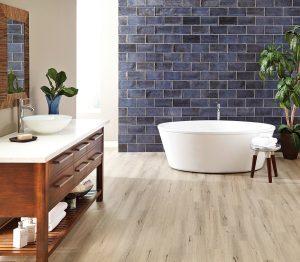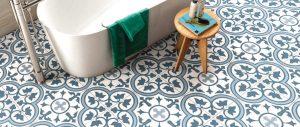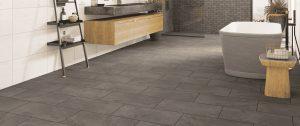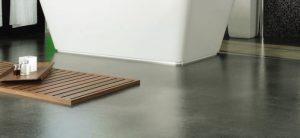 Your bathroom floor endures quite a bit from splashes at kids’ bath time and wet dog shakes to accidents and toilet overflows. Is your floor up to the task? If you are considering updating your bathroom floor, here are some aspects to keep in mind and some flooring material options for you to think about.
Your bathroom floor endures quite a bit from splashes at kids’ bath time and wet dog shakes to accidents and toilet overflows. Is your floor up to the task? If you are considering updating your bathroom floor, here are some aspects to keep in mind and some flooring material options for you to think about.
First, you should consider the size of your bathroom. This affects how much you will need to budget for, the design you choose, and whether you should hire a professional or attempt to replace the floor yourself. Clearly, the more material your bathroom requires, the higher the cost for materials will be. The size of the bathroom also impacts what style of flooring you need to achieve your design goals. For example, if you want to make your room look bigger, you may opt for larger tiles or flooring that blends with your wall color. You also need to consider the process of the installation. You may think a smaller room would make replacing the floor easier, but it could make it more difficult, particularly for an amateur, especially if large tiles or planks need to be cut to fit the space.
Another factor to think about in choosing your new bathroom floor is your budget. Keep your price range in mind as you compare different options, as some materials cost more than others. When looking at your budget to determine if you should hire a professional or do the project yourself, do not forget to factor in the cost of machinery and/or tools needed for the project. It is often less expensive to hire a professional who already has the necessary equipment than to purchase it yourself. Think long term as well. For example, you should consider your future plans in regard to resale value if you plan to sell in the near future. On the other hand, if you plan to stay in your home long-term, are you willing to pay more this year for flooring that will last, or do you want to pay less now knowing you may have to pay for a new floor again in the future due to choosing a less durable material? Will you want or need to update the sink/vanity or tub/shower in the upcoming years? If so, you risk damaging your new floor during that project or needing to replace the floor again if you need more flooring to fill in space previously covered by those fixtures. Also, if you are not planning to update other features in the bathroom soon, make sure you don’t choose flooring that is so trendy that it clashes with older pieces in the room.
In addition, when looking through your options, consider the traffic your bathroom experiences, the durability of the material, and the maintenance required. The more use your bathroom receives, the more durable the material needs to be. If you are considering updating the flooring in your small half bath that does not receive as much traffic as your other bathrooms, the durability and water resistance of the flooring you choose will not be as big of a factor as it would be for a room used for bathing. Reflect on your current life stage and the time you have to maintain your flooring with proper cleaning and long-term maintenance, such as resealing.
Here are some common materials to consider:
Ceramic Tile
 It is no wonder why ceramic tile is as popular as it is for bathrooms. Ceramic tile, especially porcelain, is quite durable and water resistant, if not completely waterproof. There are many design options to choose from within the ceramic family, and it is one of the most affordable options. Its maintenance level is rather low, as it is fairly easy to clean. Like with anything, this material has a negative side, but the positives seem to outweigh it, depending on your needs. The biggest downside is how hard and slippery ceramic can be. However, choosing a textured ceramic and/or choosing smaller tiles with more grout can decrease the risk of slipping.
It is no wonder why ceramic tile is as popular as it is for bathrooms. Ceramic tile, especially porcelain, is quite durable and water resistant, if not completely waterproof. There are many design options to choose from within the ceramic family, and it is one of the most affordable options. Its maintenance level is rather low, as it is fairly easy to clean. Like with anything, this material has a negative side, but the positives seem to outweigh it, depending on your needs. The biggest downside is how hard and slippery ceramic can be. However, choosing a textured ceramic and/or choosing smaller tiles with more grout can decrease the risk of slipping.
Natural Stone Tile
 Another resilient choice is natural stone tile. Within this category, there are several beautiful kinds of stone to choose from, each with its own characteristics. In general, stone can stand up to water well and is available in many designs that reflect nature. While it can be difficult to install, it can positively impact resale value. However, stone tile can be high maintenance, requiring finishing for slip resistance and sealing for protection, and it is one of the more expensive options. If it fits with your budget and design, it is a stunning choice that can elevate your bathroom’s appearance.
Another resilient choice is natural stone tile. Within this category, there are several beautiful kinds of stone to choose from, each with its own characteristics. In general, stone can stand up to water well and is available in many designs that reflect nature. While it can be difficult to install, it can positively impact resale value. However, stone tile can be high maintenance, requiring finishing for slip resistance and sealing for protection, and it is one of the more expensive options. If it fits with your budget and design, it is a stunning choice that can elevate your bathroom’s appearance.
Vinyl
 Types of vinyl vary, but the most durable, especially in regard to moisture, is wood plastic composite (WPC) or stone plastic composite (SPC). While other kinds may boast benefits, WPC or SPC seems to be a safer bet for use in the bathroom. These styles of vinyl are waterproof and resilient with an array of design options to get the look you want. They are typically easy to install and low maintenance. Vinyl is generally less slippery, more comfortable to stand on, and more affordable than other materials. On the other hand, it may negatively affect resale value and can show flaws in the subfloor underneath it.
Types of vinyl vary, but the most durable, especially in regard to moisture, is wood plastic composite (WPC) or stone plastic composite (SPC). While other kinds may boast benefits, WPC or SPC seems to be a safer bet for use in the bathroom. These styles of vinyl are waterproof and resilient with an array of design options to get the look you want. They are typically easy to install and low maintenance. Vinyl is generally less slippery, more comfortable to stand on, and more affordable than other materials. On the other hand, it may negatively affect resale value and can show flaws in the subfloor underneath it.
Concrete
 For a one of a kind look, consider concrete. When stained and sealed correctly, it is waterproof and can last long term. If you are concerned about slipping, you can have it sealed with a non-slip additive. Concrete is on the affordable side for materials, especially when its lifespan is considered, but it is highly recommended to leave this project to professionals. Also, due to concrete’s weight, you should seek a professional’s opinion about the strength of your subfloor, especially for above-grade rooms, before committing to it.
For a one of a kind look, consider concrete. When stained and sealed correctly, it is waterproof and can last long term. If you are concerned about slipping, you can have it sealed with a non-slip additive. Concrete is on the affordable side for materials, especially when its lifespan is considered, but it is highly recommended to leave this project to professionals. Also, due to concrete’s weight, you should seek a professional’s opinion about the strength of your subfloor, especially for above-grade rooms, before committing to it.
After considering the size of your bathroom and budget and what characteristics you should prioritize in flooring, hopefully this list helps you figure out what flooring material you should choose. Before you decide to buy your new flooring, get some samples of that material to see what design will work best in your space. Think through what your project involves and any future projects that may need to take place. You may save time and money by getting them taken care of at the same time. You also need to decide whether you want to tackle this project on your own or leave it to the professionals. Even simple projects can prove difficult for the amateur, which is why professionals are here to help. Whatever you choose, I hope you enjoy your new floors! ![]()
Kimberly McMahon
Home & Yard Magazine




